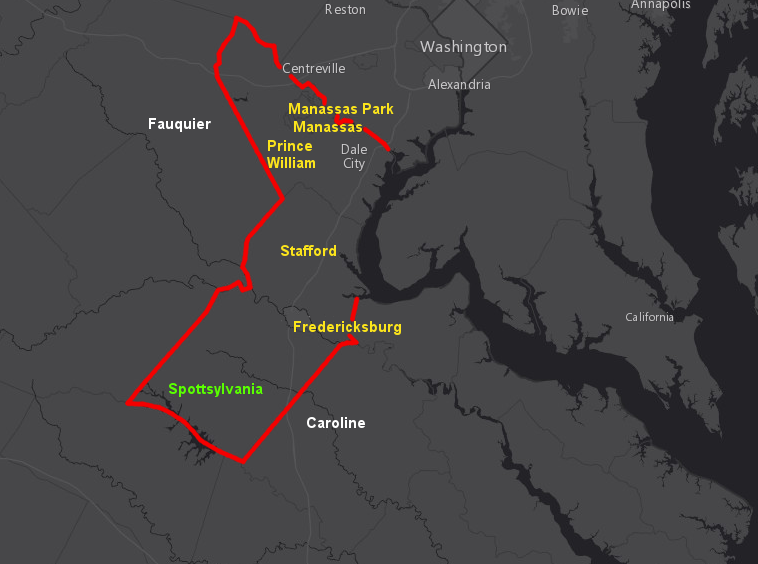
the Potomac and Rappahannock Transportation Commission has expanded since 1990 to include Spotsylvania County, but Fauquier and Caroline counties have not chosen to join
Source: ESRI, ArcGIS Online

the Potomac and Rappahannock Transportation Commission has expanded since 1990 to include Spotsylvania County, but Fauquier and Caroline counties have not chosen to join
Source: ESRI, ArcGIS Online
VRE is subsidized by the local jurisdictions through which it runs. Those counties and cities pay 50% of the operations and maintenance costs to run the trains, and riders purchasing tickets pay the other 50%. State/Federal grants are used to fund VRE's capital costs for buying locomotives and train cars, building maintenance facilities, and laying new railroad tracks.
The Virginia General Assembly created the Potomac and Rappahannock Transportation Commission (PRTC) in 1990. Initial member jurisdictions were the cities of Fredericksburg, Manassas, and Manassas Park, plus the counties of Prince William County and Stafford.
Joining PRTC was the key issue in the 2009 election for the Spotsylvania Board of County Supervisors. Spotsylvania joined because VRE agreed to extend its commuter service to a new end-of-line station near Crossroads Parkway, but the decision was politically contentious. PRTC's efforts to recruit Caroline and Fauquier counties have not succeeded yet.
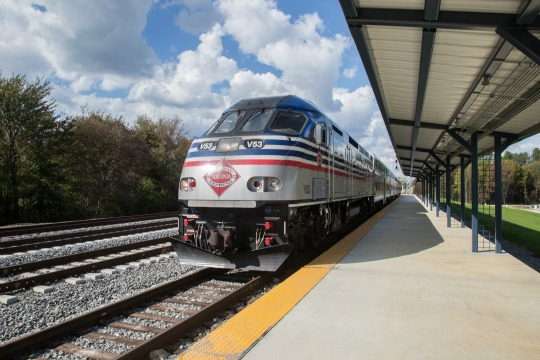
the Spotsylvania station has parking for 1,500 cars and a cover over a 700-foot platform for passengers
Source: Virginia Railway Express, Spotsylvania
PRTC jurisdictions are authorized to charge an extra 2% tax of gas/diesel sales. The tax generates the additional revenue required for the VRE subsidy. The cities and counties that joined PRTC were allowed to "make a profit" from that tax; any funds beyond the required VRE subsidy could be used by the local jurisdictions for other transportation services.
The 2% tax on retail sales was revised in 2010 to a 2.1% tax on wholesale bulk deliveries of motor fuels, in order to reduce the number of sources from which the tax had to be collected. Since wholesale prices are lower than retail prices, the tax was increased by an extra 0.1% ensured that the total revenue to local jurisdictions would not be reduced.
PRTC has sought to expand the number of jurisdictions that provide subsidies for VRE. If additional counties could be convinced to join, the existing members could reduce their annual contribution.
In 1985, Spotsylvania County declined to participate in plans to launch VRE. At the time, the supervisors did consider their county to be part of Northern Virginia.
One supervisor stated "I'm not going to spend our taxpayers' money on that. As far as I am concerned, they can ride a bike to work" and another added "or a donkey." Another concern expressed at the time was that increased commuter service would spur excessive housing development in Spotsylvania.1
VRE proceeded to build its Crossroads train storage yard and maintenance facility in Spotsylvania County, where land costs were relatively low. The end-of-line station of the commuter railroad was placed six miles north in downtown Fredericksburg. Spotsylvania County residents could ride the commuter train, but had to drive to Fredericksburg to catch it.
The population of Spotsylvania County increased from 57,403 in 1990 to 122,397 in 2010. A significant number of the new residents commuted north to jobs in the DC area, and the political priorities in the county changed.2
VRE proposed to build a new commuter station next to the Crossroads railyard, expanding commuter rail service to the south in order to entice Spotsylvania into joining PRTC. In a 4-3 vote in August, 2009, the Board of Supervisors decided to become a member and add the extra gas tax to fund Spotsylvania's subsidy for VRE service, but the board postponed final action until after the election in November. That delay allowed county voters to shape the final decision, since two of the four supervisors who had voted to join PRTC were challenged by candidates who promised to back out of the VRE deal.
One of the two incumbents who voted to join in 2009 had previously been opposed to that action. He changed his mind after seeing gas prices were the same in Spotsylvania County as in adjacent Fredericksburg and Stafford County, which had imposed the 2% tax. The gasoline suppliers and retailers were charging the same price as in the PRTC jurisdictions, and pocketing an extra $3 million in profit annually from sales in Spotsylvania County.
The supervisor who changed his mind wanted those funds applied to transportation projects in Spotsvania County, otherwise:3
After supervisors supporting VRE won the election, the county joined PRTC as planned. In 2013 VRE opened the new Spotsylvania commuter rail station just south of Route 17, near VRE's Crossroads train storage yard.
To minimize conflict with CSX freight traffic, VRE built 2.5 miles of new railroad to create a third track between Hamilton Crossing south to the Crossroads yard.4
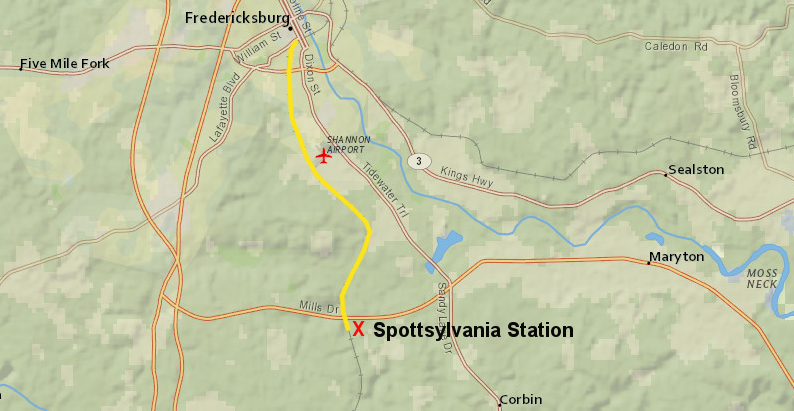
the Spotsylvania station is six miles south of the former end-of-line station in downtown Fredericksburg
Source: ESRI, ArcGIS Online
Spotsylvania County began to charge that extra 2% tax on gasoline/diesel sales, and in exchange committed to pay an annual VRE subsidy. The county's subsidy payment for VRE required only 35% of the extra gas tax revenues raised in Spotsylvania during the first 2.5 years of PRTC membership. The county was able to use the remaining 65% (over $8 million) for other local transportation projects, including FREDericksburg Regional Transit costs.5
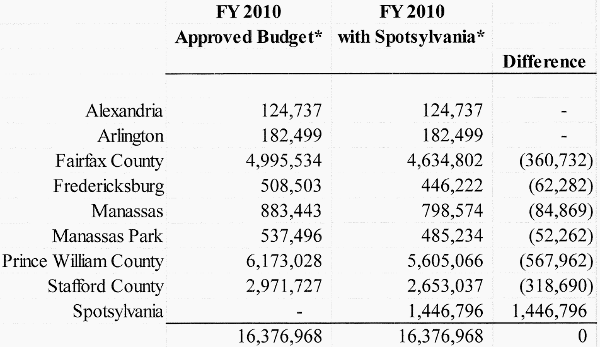
adding Spotsylvania reduced the subsidies required of other jurisdictions that subsidize VRE's operations and maintenance costs
Source: Potomac and Rappahannock Transportation Commission, Revisions to the Virginia Railway Express Master Agreement to Add Spotsylvania County (October 20, 2009)
Fauquier County has never become a member of PRTC. That county pays nothing to support VRE's operations and maintenance costs, though residents from Fauquier County drive to the Broad Run station and catch the commuter train. VRE customers who come from jurisdictions outside PRTC are not complete "free riders" since they pay the fare, but the fares paid by Fauquier residents cover only 50% of the cost of their train ride. The jurisdictions that do belong to PRTC must provide the other 50%, and Fauquier County itself contributes nothing.
In 2005, PRTC calculated that by joining PRTC, Fauquier County would make a profit. The county would be authorized to add an extra 2% tax on all gasoline/diesel sales, but only 15% of the revenue generated by that tax would be needed for the VRE subsidy. Fauquier County could use the remaining extra revenue to fund other local transportation projects. Fauquier County supervisors still chose to pass up the opportunity.6
Caroline County rejected the option of joining PRTC and getting a commuter rail station in 2007 and again in 2013. Caroline officials anticipating raising over $6 million from the 2% tax, and a VRE station at Carmel Church might spur development of 1,100 acres already zoned for mixed use development. The political challenge of raising the gas tax was greater than the speculative benefits of new development, and the supervisors declined to join PRTC.7
A 2008 study considered locating a train station at the center of a proposed Transit Oriented Development project. The proposal projected construction during the next 20 years of 1.5 million square feet of office/retail development and almost 4,000 new residential units. The residents were expected to commute to jobs in Richmond or Northern Virginia/DC, because the local economy was not robust enough to absorb that number of workers.8
Expanding service south to Caroline County on the Fredericksburg Line would involve building a third rail line north to the Crossroads station in Spotsylvania. CSX would require that third track to minimize conflicts with the private railroad's revenue-producing freight trains.
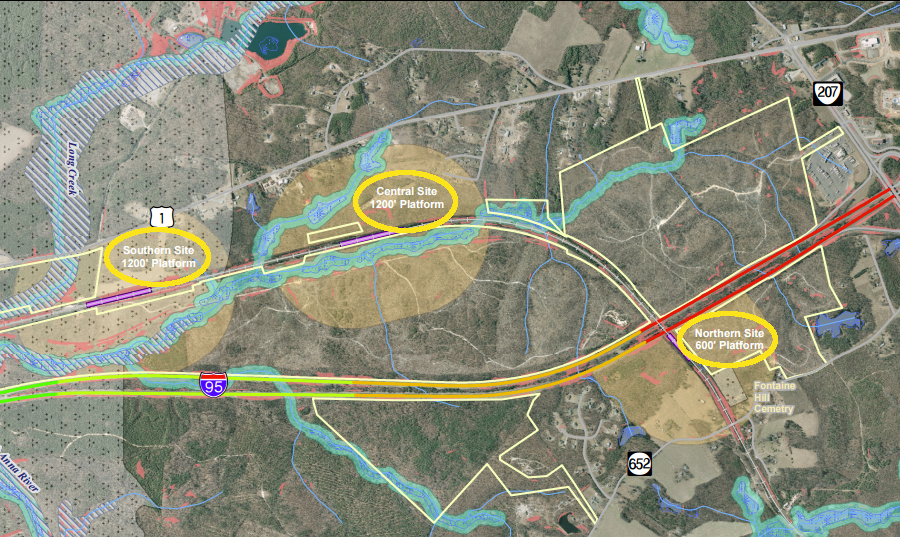
Caroline County studied potential passenger train station sites that would support Transit Oriented Development
Source: Caroline County, Caroline County Transit Oriented Development Study (Figure 1)
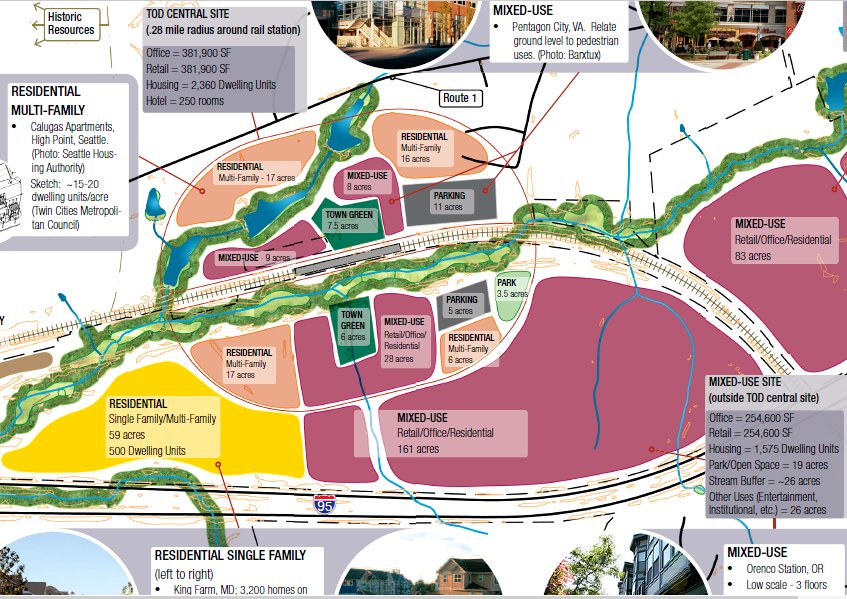
high-density development with a new passenger train station has been proposed at Carmel Church in Caroline County
Source: Caroline County, Transit Oriented Development Study (Figure 3)
Expanding VRE's separate Manassas Line also would require adding an additional track on the Norfolk Southern Railroad, to mitigate similar scheduling conflicts between freight/passenger trains.
Starting in 2014, VRE made a serious effort to extend its system west to Haymarket. The 11-mile extension would close the existing Broad Run Station and replace it with a new end-of-line station in Haymarket, with two intermediate stations at Innovation and Gainesville. The proposed expansion would require double-tracking or even triple-tracking the current "B Line" of Norfolk Southern, built originally by the Manassas Gap Railroad before the Civil War.
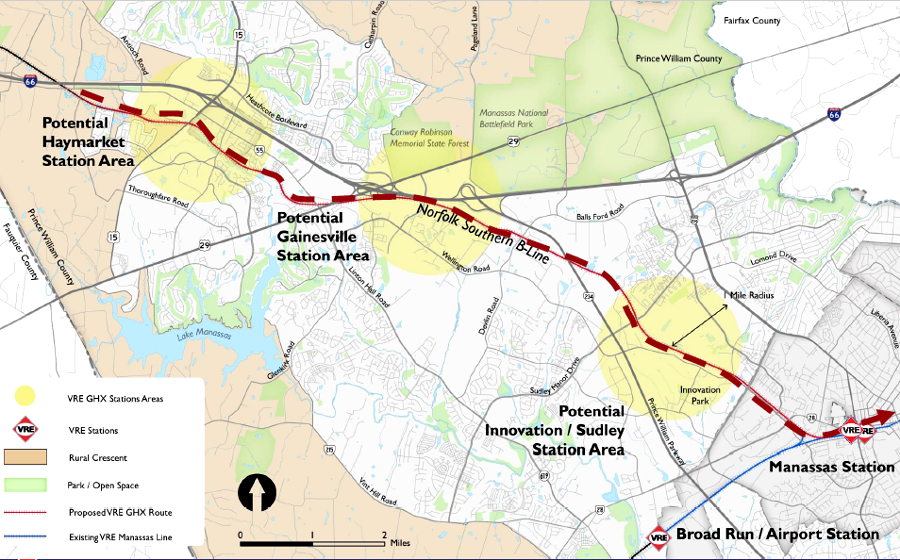
in 2016, VRE planned to build an 11-mile extension to Haymarket with intermediate stations at Innovation and Gainesville
Source: Virginia Railway Express, Community Meeting #2 (April 27, 2016)
VRE saw the extension as a way to increase its market share. As described in the VRE Strategic Plan:9
The proposed extension would be located within Prince William County. It would require constructing a new railyard west of Haymarket, and one option was to place that facility in Fauquier County.
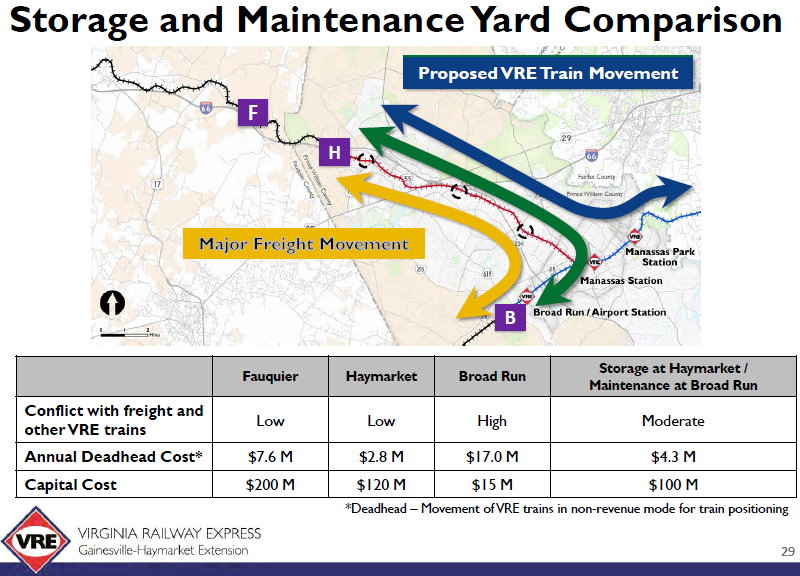
if VRE built a station west of Innovation, it needed to build a new railyard west of that station too in order to minimize costs of shuttling trains from storage into service
Source: Virginia Railway Express, Community Meeting #2 (April 27, 2016)
VRE did not propose building a new passenger station in Fauquier County, because west of Haymarket there was just low-density development. There was little incentive for Fauquier County to join PRTC, and local supervisors had no desire to impose an extra gas tax on voters. Without adding a new jurisdiction to PRTC, the extension would not generate new subsidy revenue.
Bundled with the project was a proposed increase in the number of commuter trains running in the morning and evening, adding three in the morning and three more at night. Politically, any possible relief for commuters was of great interest in the traffic-clogged area.
VRE floated the idea that it could offer service every hour during the day, running an "off-peak shuttle" between rush hours to the Alexandria station. VRE trains could not go all the way to Union Station during those shuttle trips, because the CSX contract limited the number of trains allowed north of Alexandria. Customers could use Metrorail between Alexandria and points north, however. And off-peak shuttle that provided seven trips into Alexandria and seven return trips during the day (14 additional trips/day) would convert VRE from a commuter rail system, with limited service at rush hour, into a transit system.
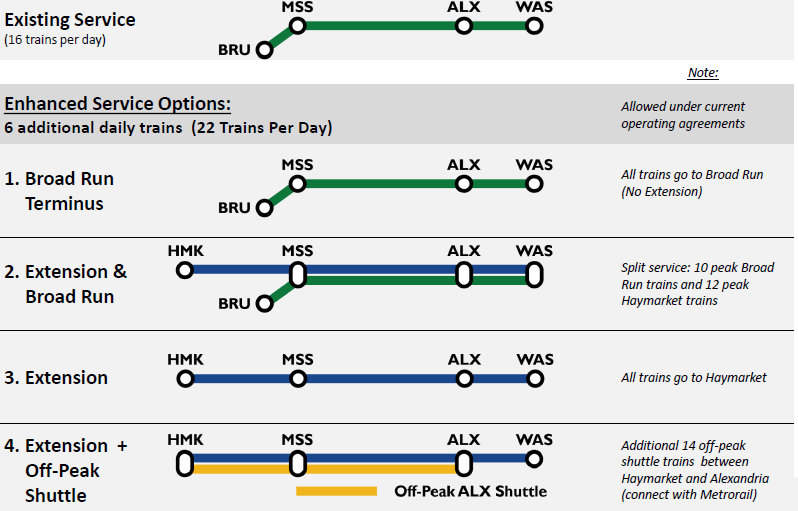
all of VRE's proposed service plans assumed six more trains daily for commuters, and one option included running an off-peak shuttle to Alexandria throughout the day
(BRU=Broad Run station, HMK=Haymarket, MSS-Manassas, ALX=Alexandria, WAS=Washington)
Source: Virginia Railway Express, Community Meeting #2 (April 27, 2016)
The Town of Haymarket was the first group to object to VRE's plans. In 2009, the Town of Haymarket officially expressed its opposition and encouraged an end-of-line stop at Gainesville. Additional train noise and disrupting the North Fork wetlands near Route 15 caused concerns.
More significantly, town officials feared a twice-a-day traffic jam of commuters driving into a garage, then driving directly home without shopping or eating in Haymarket. The town would get the negatives of added highway congestion, but no economic benefits. By 2015, however, town officials endorsed the extension.10
Prince William County's economic development officials were boosters of VRE expansion, and supported building the two other stations as well as the end-of-line station at Haymarket. The basic assumption was that commuter rail increased land values, which increased property taxes. Commuter rail was also thought to make an area more attractive for businesses that might bring jobs and economic development.
The county saw VRE as an incentive for businesses to locate at Innovation, a 1,600-acre office/technology park where George Mason University built its Prince William campus. County officials have sought various transportation upgrades to make Innovation into a job center. However, privately-funded development has focused further west along the Route 29 corridor, creating shopping centers such as Virginia Gateway and mixed use communities several miles from Innovation. VRE's tentative station locations were at least a half-mile from Innovation.11
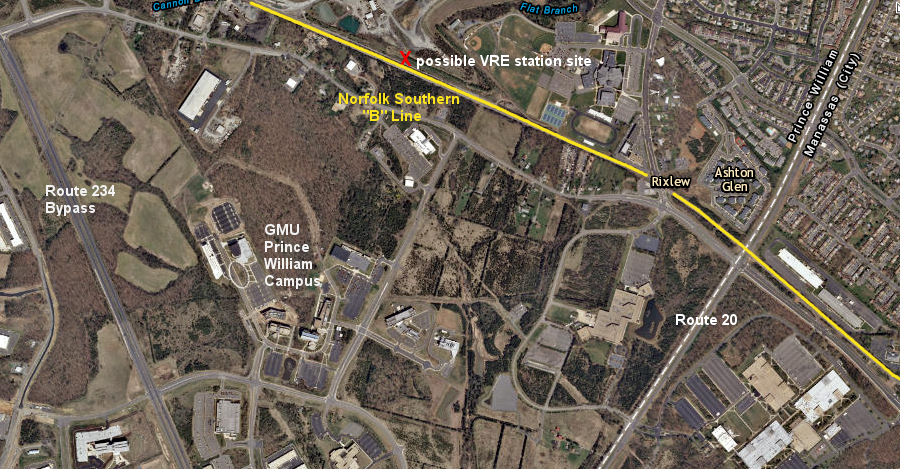
VRE assumed a station at Innovation would be located at least 1/2 mile away from the GMU campus, which makes development at Innovation only marginally "walkable"
Source: ESRI, ArcGIS Online
Until the end of its study of the Gainesville-Haymarket extension, VRE kept its options open for where to locate the three stations proposed along the line. The multiple jurisdictions that manage VRE share some expansion costs for capital equipment and new railroad track, but whenever a new station is built the local jurisdiction (not the entire VRE partnership) pays for the station's construction.
Spotsylvania County had received a state grant to offset some costs of its Crossroads station and parking lot. VRE and county officials anticipated that developers would steer the final decisions on station locations. Proffers of land and funding to construct a new VRE station at specific locations were anticipated as part of rezoning proposals, and one-three new stations in Prince William would be subsidized by private funding. Local businesses were also projected to fund shuttle bus services between VRE stations and workplaces in the corridor, creating a new train-oriented community centered on the corridor's rail service.12
Developers willing to fund VRE capital improvements would seek a rezoning that increased authorized density of housing. Increased density would be essential for Transit Oriented Development to create a "walkable community" where residents could get to the train station without driving. Developers would also seek to lower the required proffers for transportation improvements, based on predictions of lower-than-average traffic impacts as commuters used VRE and did not increase highway congestion.
In the 1990's, requests for lower transportation proffers were part of the proposals for rezoning vacant land at the Vienna Metro station. Officials in the Town of Vienna understood the concepts of Transit Oriented Development, but still demanded smaller-scale, less-dense housing.
Vienna town officials calculated that some workers living next to the Metro station would take the Orange Line to work, but others in the household would still drive to jobs in the area. In addition, high-density development would result in high traffic congestion, as new residents made shopping and other trips after the work day. The tall towers originally proposed north of the Metro station were dropped, and four-story townhomes were built instead.13
For the Gainesville-Haymarket extension, VRE analyzed the projected increase in ridership and costs for two choices. The preferred alternative was building 11 miles of new track, and three new stations, while closing the Broad Run station. The main alternative was maintaining the existing Broad Run Station. The existing passenger platform at Broad Run blocked the expansion of the railyard there, so the "No Action" alternative was inconsistent with proposals to add more commuter trains.
The toughest problem VRE faced was the benefit/cost ratio for the extension vs. the "No Action" alternative. The commuter rail system projected that one-time capital costs would be $300 million more, but state/Federal grants would cover those costs. The biggest hurdle turned out to be the proposed increase in the annual subsidy required from local jurisdictions.
Running trains the extra 11 miles from Haymarket would cost $9 million more. Prince William County would pay most of the additional subsidy, causing elected officials to focus closely on the proposal. The ridership difference between the extension vs. "No Action" was only 350 people/day in the year 2040, when the population projections were at their highest and benefits most clear.

the additional distance from Haymarket would increase operations and maintenance costs, which are subsidized 50% by local jurisdictions, from $36 million/year to $45 million/year
Source: Virginia Railway Express, Community Meeting #2 (April 27, 2016)
For its statistics, VRE counts commuters as a "rider" inbound in the morning and as a second "rider" outbound in the evening. As a result, 700 "riders" equal 350 people commuting in both directions. If each commuter was driving alone, then the extension to Haymarket would remove 350 cars from the highways. If the High Occupancy Toll (HOT) on I-66 stimulated those 350 riders to join a carpool with a minimum of three members, then the reduction could be as low as 117 cars/day.14
Removing 350 cars from I-66 would not make a significant difference in traffic congestion, since one lane of traffic moves 2,000 vehicles per hour.15
The annual subsidy of $25,000/person to achieve that reduction, compared to the "No Action" alternative, was perceived by local officials as excessive. At the VRE Operations Board meeting in September, 2016, Prince William County's representatives made clear that the proposed Gainesville-Haymarket extension was not viable. The actual language used at the meeting was more blunt, but the minutes recorded a county supervisor saying:16
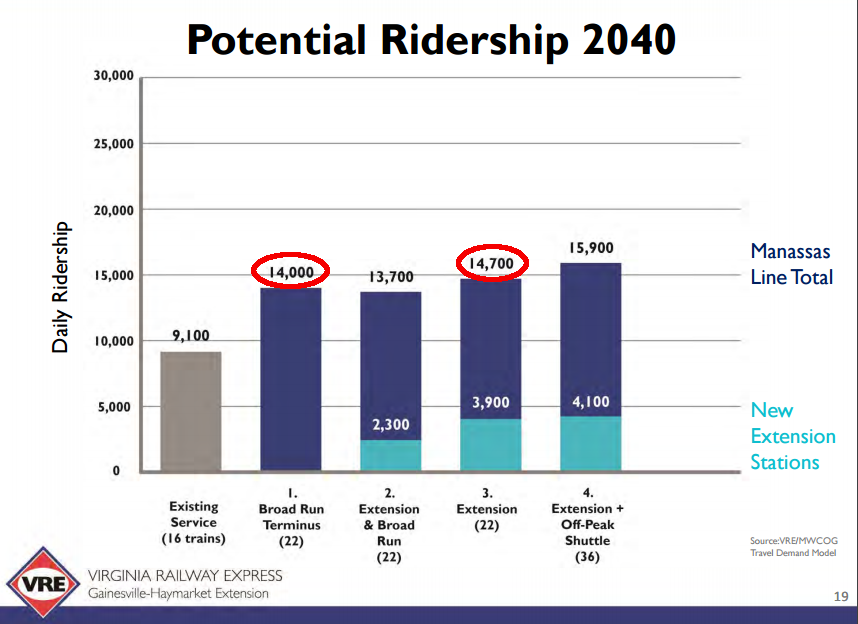
an increase of 700 in "ridership" equals 350 more commuters taking the train in the morning and 350 commuters returning in the evening
Source: Virginia Railway Express, Community Meeting #2 (April 27, 2016)
The "No Action" alternative would leave VRE with inadequate parking for increasing the number of commuter trains. One option not fully explored in the initial analysis was to built just one new train station near Broad Run, and then close the existing Broad Run station. The passenger platform at Broad Run would be removed, and the space used for maintenance and storage.
VRE planned to build a 700-space parking garage, costing over $20 million, at its Broad Run station. Broad Run was built as the end-of-line station with 350 parking spaces in 1992. After three expansions it offered 1,072 spaces, but by 2012 parking was at 97% of capacity. The commuter rail system had to decide on moving the end-of-line station to Godwin Road or Innovation before expending significant funds on that multi-story garage.17
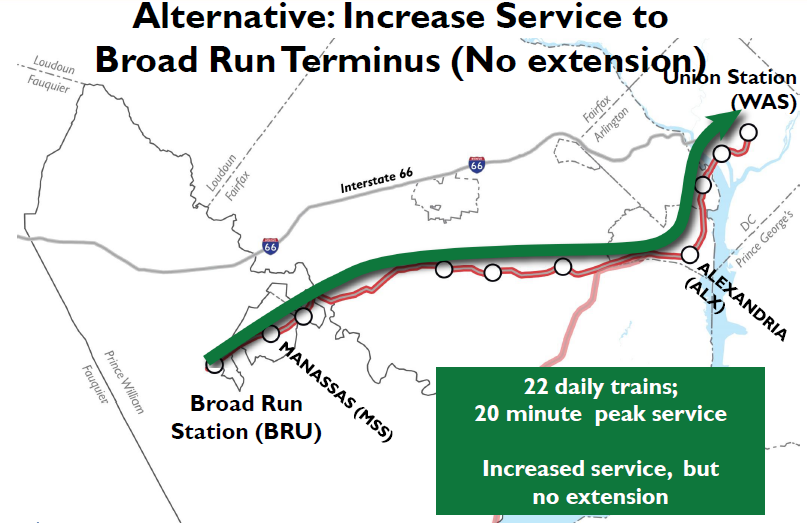
one option was to add an off-peak shuttle without the extension to Haymarket
Source: Virginia Railway Express, Community Meeting #2 (April 27, 2016)
All investments at Broad Run were inconsistent with the concepts of Transit Oriented Development. That end-of-line station is located next to Manassas airport, within the Airport Overlay District. Restrictions on height, and concerns about safety, would limit the potential to build a mixed use, transit-oriented community there.
Parking garages can be financed with revenue bonds by public agencies at a low cost, so such garages can be used to attract a private developer, generate jobs, and shape the development of an area. For example, the Virginia Department of Transportation located a new 1,000 space garage for I-95 commuters at Stonebridge in Prince William County, and that helped to clinch the deal for the owner of a minor league baseball team (Potomac Nationals) to build a new stadium at the site. Baseball fans will be able to park in the garage at night and on weekends, when otherwise the facility would be empty.
VRE's options to create Transit Oriented Development at Broad Run are limited. The airport's safety zone blocks most options for high-density residential development.
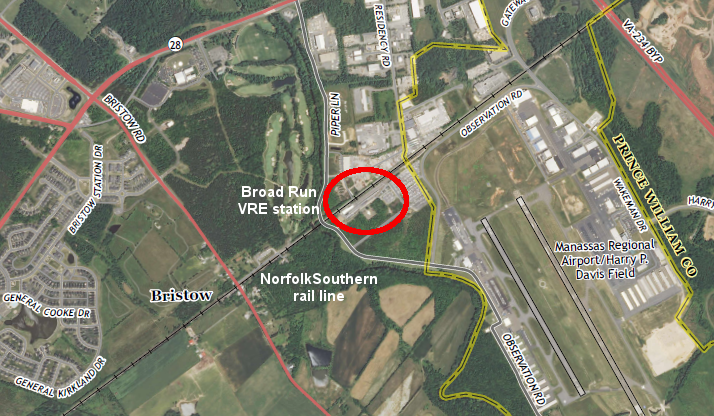
because the Broad Run VRE station is next to Manassas airport, there is limited potential to use a planned $20+ million parking garage for more than just commuter parking
Source: US Geological Survey (USGS), Nokesville 7.5x.5 topographic quadrangle (Revision 1, 2013)
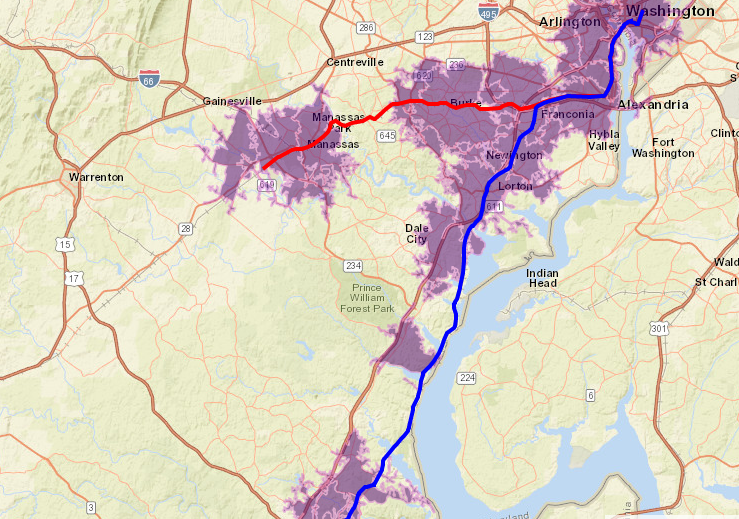
residents living within a 10 minute drive of a VRE station (purple zone)
Source: ESRI, ArcGIS Online
1. "VRE back in 1985," Free Lance-Star, September 11, 2009, http://news.fredericksburg.com/spotsygovt/2009/09/11/vre-back-in-1985/ (last checked August 7, 2013)
2. "American FactFinder," Bureau of Census, http://factfinder.census.gov/faces/nav/jsf/pages/community_facts.xhtml; "Population of Counties by Decennial Census: 1900 to 1990," Bureau of Census, https://www.census.gov/population/cencounts/va190090.txt (last cjecked October 10, 2016)
3. "VRE: Spotsy election issue?," Fredericksburg Free Lance-Star, August 30, 2009, http://www.fredericksburg.com/local/vre-spotsy-election-issue/article_faf5bf1d-ec02-5cee-b0cf-87c895b1e97c.html (last checked October 10, 2016)
4. "Crossroads to Hamilton (Spotsylvania Third Track)," Virginia Railway Express, http://www.vre.org/projects-plans-facility/projects/third-track/; "VRE kicks off major expansion plan with new Spotsylvania station," Washington Post, April 18, 2015, https://www.washingtonpost.com/local/trafficandcommuting/vre-kicks-off-major-expansion-plan-with-a-new-spotsylvania-county-stop/2015/04/18/63576394-e1f8-11e4-b510-962fcfabc310_story.html (last checked October 10, 2016)
5. "VRE, taxes top issues in Spotsylvania board races," Free Lance-Star, October 18, 2009, http://fredericksburg.com/News/FLS/2009/102009/10182009/500696; "DID YOU KNOW?," Crossroads Station, June 3, 2013 newsletter, http://csvre.com/Newsletter_articles.html (last checked August 7, 2013)
6. Alfred Harf, "Public Transportation Service Prospects in Fauquier County," Potomac and Rappahannock Transportation Commission, January 2005,
http://www.fauquiercounty.gov/government/departments/BOS/pastagendas/01-13-05/PRTC/PRTC_files/frame.htm (last checked August 8, 2013)
7. "Caroline looking into joining VRE group," Free Lance-Star, June 2, 2013, http://news.fredericksburg.com/newsdesk/2013/06/02/caroline-looking-into-joining-vre-group/ (last checked August 7, 2013)
8. "Caroline County Transit Oriented Development Study," Caroline County, October 2008, p.10, http://www.virginiadot.org/projects/vtrans/resources/caroline%20tod%20study_final.pdf
9. "Virginia Railway Express Gainesville-Haymarket Extension Implementation Plan," Virginia Department of Rail and Public Transportation, December 1, 2005, p.11, http://vre.org/about/G-H/PDF/Gainesville-Haymarket.pdf; "Virginia Railway Express Strategic Plan 2005-2025," Virginia Railway Express, May 2004, p.76 http://www.vre.org/about/strategic/strategic_plan.htm (last checked August 8, 2013)
10. Minutes, Town of Haymarket, May 4, 2009, http://townofhaymarket.org/documents/5-4-2009Signed.pdf (no longer available online); "Minutes," Potomac and Rappahannock Transportation Commission (PRTC), May 7, 2009, p.5, http://www.prtctransit.org/docs/commission/May2009/Adopted_Minutes_5-09.pdf; "Prince William leaders on board with VRE extension to Gainesville, Haymarket," Potomac Local, May 7, 2015, http://potomaclocal.com/2015/05/07/prince-william-leaders-on-board-with-vre-extension-to-gainesville-haymarket/ (last checked October 10, 2016)
11. "Innovation Technology Park," Prince William County Department of Economic Development, http://www.pwcecondev.org/LocatinginPWC/InnovationTechnologyPark.aspx; "Virginia Railway Express Gainesville-Haymarket Extension Implementation Plan," Virginia Department of Rail and Public Transportation, December 1, 2005, p.9, http://vre.org/about/G-H/PDF/Gainesville-Haymarket.pdf (last checked August 8, 2013)
12. "Virginia Railway Express Gainesville-Haymarket Extension Implementation Plan," Virginia Department of Rail and Public Transportation, December 1, 2005, p.7, http://vre.org/about/G-H/PDF/Gainesville-Haymarket.pdf (last checked August 9, 2013)
13. Zachary Schrag, The Great Society Subway: A History of the Washington Metro, John Hopkins University Press, 2006, p.237
14. "How Many Cars Would VRE Extension to Gainesville-Haymarket Remove From I-66? You Do the Math," Prince William Conservation Alliance, May 7, 2016, https://pwconserve.wordpress.com/2016/05/07/how-many-cars-would-vre-extension-to-gainesville-haymarket-remove-from-i-66-you-do-the-math/ (last checked October 10, 2016)
15. "Community Meeting #2" Powerpoints, Virginia Railway Express, Slide 6, http://www.vre-ghx.org/community-meeting-2/, April 27, 2016 (last checked October 10, 2016)
16. "Minutes," VRE Operations Board Meeting, September 16, 2016, http://www.vre.org/about/board/board-agenda-minutes/2016/September/vre-minutes-09-16-16-clean-draft-pdf/ (last checked October 10, 2016)
17. "Broad Run Parking Information," Virginia Railway Express, http://www.vre.org/service/stations/bruparking.htm; "Minutes," VRE Operations Board Meeting, February 19, 2010, http://www.vre.org/about/Ops_board_items/2010/february/minutes.pdf (last checked August 8, 2013)
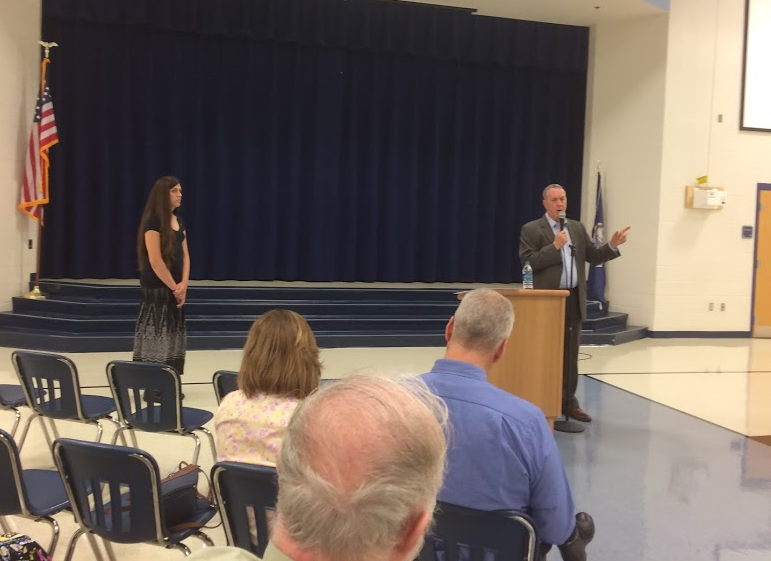
VRE's Chief Executive Officer Doug Allen, discussing commuter rail at one of Del. Danica Roem's town halls in 2018